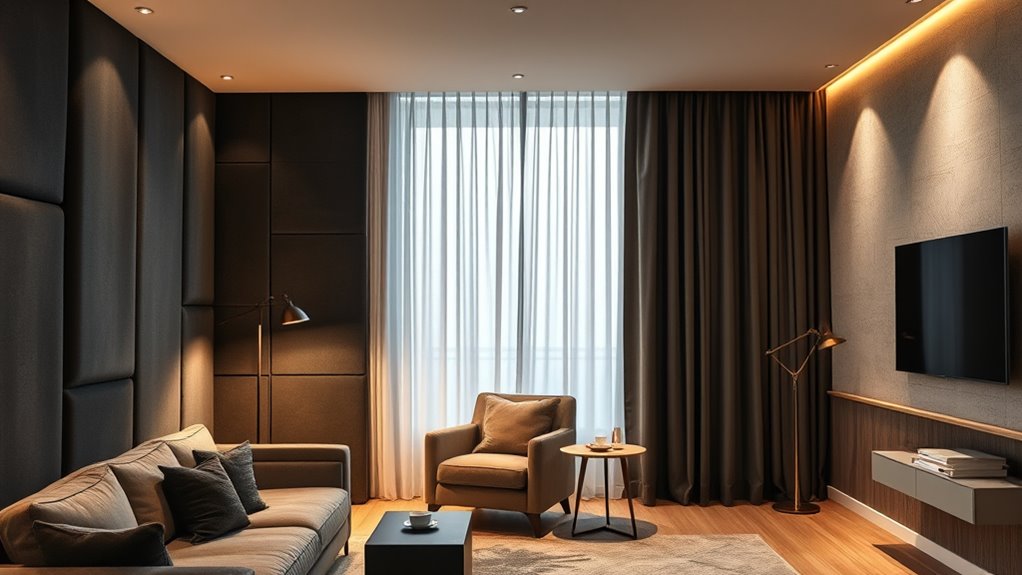To create quiet spaces in a full house, start by adding acoustic panels to absorb sound and reduce echoes. Seal gaps around doors and windows to block external noise leaks. Use thick curtains, rugs, or soundproof window inserts to minimize street noise, and add mass with drywall for better insulation. Combining these solutions offers an all-encompassing approach. If you want to discover more effective methods, you’ll find useful tips and resources as you explore further.
Key Takeaways
- Use acoustic panels strategically on walls to absorb sound and reduce echoes throughout the house.
- Seal gaps around doors and windows to block external noise and prevent internal sound leaks.
- Incorporate additional measures like weatherstripping, thick curtains, and rugs to enhance overall soundproofing.
- Combine multiple solutions, such as acoustic panels and door seals, for comprehensive noise reduction.
- Explore professional soundproofing materials and techniques for optimal results in busy or shared spaces.

Are noisy neighbors or busy streets disrupting your peace? If so, you’re not alone. Many people struggle to find quiet in a bustling household or in a neighborhood full of activity. Luckily, there are practical solutions to help create a calmer environment. One of the most effective ways to reduce unwanted noise is by installing acoustic panels. These panels absorb sound waves, preventing echoes and muffling external noises. You can strategically place them on walls, especially in shared spaces or rooms where you spend a lot of time. Acoustic panels come in various styles and sizes, so you can choose options that blend seamlessly with your decor. They’re relatively easy to install and provide immediate relief from noise disturbances.
Alongside acoustic panels, don’t overlook the importance of sealing gaps around doors and windows. Door seals are a simple yet powerful tool to block out sound leaks. When your doors don’t fit snugly in their frames, noise easily slips through, spoiling the tranquility of your space. By adding door seals, you create a tighter barrier that keeps outside noise from entering and prevents interior sounds from escaping. This is especially helpful if you work from home or need a quiet space for relaxation. Door seals are affordable, straightforward to install, and can be customized to fit any door size. When combined with acoustic panels, they form a thorough approach to soundproofing that dramatically enhances the comfort of your home.
If you want to go further, consider using weatherstripping around windows and doors to improve overall sound insulation. Thick curtains or soundproof window inserts can also considerably reduce street noise. For shared walls, adding mass with drywall or specialized soundproofing materials can make a noticeable difference. Remember, reducing noise isn’t just about blocking out external sounds; it’s also about minimizing internal noise transfer between rooms. Using soundproofing materials can significantly enhance the effectiveness of your efforts. For example, incorporating soundproofing techniques used in professional settings can provide even better results. Think about using rugs, furniture, or fabric wall hangings to absorb sound within your space. Each small step contributes to a quieter, more peaceful environment.
In the end, creating a quiet space in a full house requires a combination of solutions. Acoustic panels and door seals are two of the most accessible and effective options that you can implement quickly. They help you regain control over your environment, making your home a sanctuary amid the chaos. With a little planning and effort, you can enjoy peaceful evenings, focused work sessions, or restful sleep, regardless of what’s happening outside. Additionally, if you’re considering retail hours for shopping or supplies, many stores offer extended hours or online options to help you access soundproofing materials at your convenience. Exploring soundproofing solutions tailored for busy households can also provide additional strategies to enhance your home’s tranquility. Incorporating innovative materials into your soundproofing plan can further optimize noise reduction and comfort.
Frequently Asked Questions
What Are the Most Cost-Effective Soundproofing Options?
If you’re looking for cost-effective soundproofing options, start with DIY techniques using budget-friendly materials. You can add heavy curtains, rugs, or furniture to absorb sound, and install foam panels or weatherstripping around doors and windows. These solutions are affordable and easy to implement, making a noticeable difference without breaking the bank. With a little effort, you can create a quieter space that fits your budget and needs.
How Long Does It Take to Install Soundproofing Solutions?
The installation timeline for soundproofing solutions varies depending on the project size and materials used. Typically, you can expect a few hours to a few days for completion. Proper project planning is essential to guarantee a minimal disruption and ensure efficient progress. If you’re prepared and coordinate with professionals, the process can be smooth and quick, allowing you to enjoy your quieter space sooner.
Can Soundproofing Be Done Without Professional Help?
Ever feel like silence is a distant dream? You can definitely tackle soundproofing without professional help using DIY methods. With some patience and basic tools, you can add mass to walls, seal gaps, or hang soundproof curtains. Budget tips include repurposing materials and prioritizing key areas. While it takes effort, creating a quieter space is achievable on your own, turning chaos into calm one step at a time.
What Materials Are Best for Soundproofing Shared Walls?
When soundproofing shared walls, you should use effective materials like acoustic panels and drywall insulation. Acoustic panels absorb sound waves, reducing noise transmission, while drywall insulation adds a barrier to block sound. You can install these materials yourself with some basic tools, making it a cost-effective DIY project. Combining acoustic panels with proper insulation creates a quieter, more peaceful environment in your home.
How Do I Soundproof a Room for Sensitive Equipment?
Imagine your sensitive equipment as a delicate butterfly needing protection from outside storms. To soundproof your room, you’ll want to focus on equipment isolation and vibration dampening. Use thick, dense materials like mass-loaded vinyl or acoustic panels to block noise. Place isolation pads under equipment to prevent vibrations from traveling. Seal gaps and doorways tightly. These steps create a calm sanctuary where your equipment can operate quietly and securely.
Conclusion
By exploring soundproofing solutions, you’re gently shaping a more peaceful home environment. While it’s impossible to silence every whisper of life outside your walls, these steps help create a cozy retreat where everyday noise fades into the background. Think of it as tuning your space to a softer, more harmonious note—one that offers comfort without losing the lively charm of a full house. With a little effort, you’ll find your home becoming a refuge of calm amid the bustling world.









